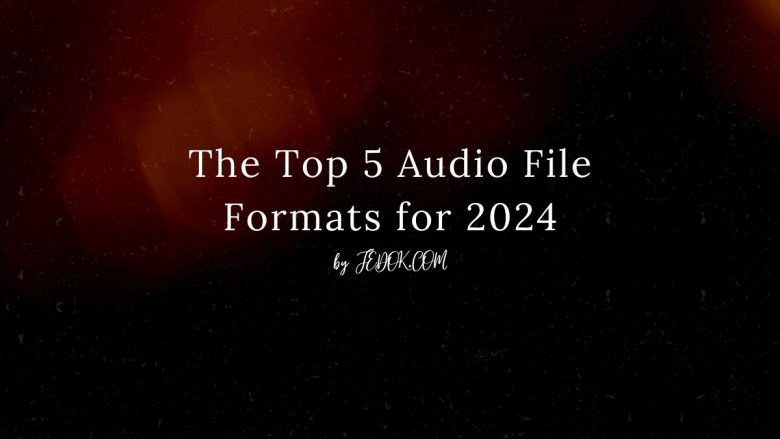
In digital audio, selecting the appropriate file format can profoundly influence sound quality, consistency, and efficiency. It holds particular importance for music enthusiasts, podcasters, and audio professionals, who must carefully choose the optimal audio format to achieve optimal results. In this guide, we’ll delve into the top five audio file formats for 2024, taking into account factors such as compression efficiency, fidelity, and versatility. Additionally, we’ll explore the importance of adaptability and meticulousness in choosing the right format for various audio applications.
1. FLAC (Free Lossless Audio Codec)
FLAC stands as one of the most popular lossless audio file formats, celebrated for its capacity to compress audio without sacrificing quality. In contrast to lossy formats such as MP3, FLAC meticulously preserves every nuance of the original audio, appealing greatly to audiophiles and music enthusiasts who prioritize pristine sound reproduction. Consequently, FLAC’s widespread adoption underscores its significance in catering to the discerning preferences of those who value audio quality above all else.
One big advantage of FLAC is its support for high-resolution audio. It includes formats like 24-bit and 192 kHz. These create an immersive listening experience for smart listeners. Flac lines are widely supported. They work on both colorful playback biases and software operations. This makes FLAC a good choice for both personal and professional audio.
2. AAC (Advanced Audio Coding)
AAC has become a top audio file format. It’s known for its good compression and better sound quality than old codecs like MP3. The MPEG group developed AAC. It offers big bitrate savings while keeping quality. This makes it a top choice for digital music and streaming.
AAC has a key feature: it supports multi-channel audio and advanced garbling. These include spectral band replication (SBR) and parametric stereo (PS). They allow for immersive sound. AAC has wide support across platforms and biases. It will still be a dominant audio format in 2024. This is especially true for online streaming and digital radio.
3. Opus
Opus has gained traction as a versatile audio codec, designed to deliver high-quality sound across various applications. Voice communication, music streaming, and online gaming all benefit from Opus’s capabilities. Developed by the Internet Engineering Task Force (IETF), Opus offers low latency, robust error resilience, and adaptive bitrate control, making it ideal for real-time communication scenarios. Additionally, its widespread adoption underscores its effectiveness in meeting the diverse needs of modern audio transmission. Therefore, Opus stands as a testament to innovation in audio technology, facilitating seamless communication experiences across different platforms and environments.
Opus boasts a notable strength: its ability to adapt to various network conditions, ensuring consistent audio quality even in challenging environments such as limited bandwidth or packet loss. Supported by major web browsers and communication platforms, Opus has emerged as the preferred choice for VoIP services. Moreover, its popularity extends to remote collaboration and multimedia applications, where its resilience and versatility shine. Consequently, Opus stands as a cornerstone in facilitating seamless communication and collaboration experiences across diverse platforms and scenarios.
4. WAV (Waveform Audio File Format)
WAV stands out as a premier audio file format renowned for its simplicity, universality, and high-quality uncompressed audio. Unlike many other formats, PCM, remains unaltered, preserving the original audio fidelity. This characteristic makes WAV highly sought after for professional audio editing, mastering, and archival purposes. Consequently, WAV maintains its status as a preferred choice among professionals seeking pristine audio quality and uncompromising reliability.
One of the main advantages of WAV is its broad support. It works across different hardware and software. It allows flawless playback and editing on many types of devices and systems. Also, WAV supports colorful audio judgments and channel setups. It meets the needs of musicians, sound experts, and content creators.
5. MP3 (MPEG Audio Layer III)
MP3 is old. But it still applies in 2024. This is thanks to its wide use, friendliness, and good compression. Newer codecs have better sound at lower bitrates. But MP3 is still practical for daily listening. It’s also useful for music distribution and older devices.
MP3’s enduring strengths are its familiarity and ubiquity. It works on all digital audio platforms. It also plays flawlessly on a wide range of devices, software, and media players. Newer formats may offer better sound. But MP3 is dependable for consumers and content creators. Its effectiveness and wide support make it so.
Conclusion:
In conclusion, choosing the stylish audio train format in 2024 involves considering factors. These include sound quality, compactness, comity, and intended use. You may prioritize lossless dedication, effective contraction, or broad comity. The top five formats mentioned offer different options to suit your audio needs. Stay informed about the latest audio technology. It will help your music, podcasts, and other audio sound good. This is important in the ever-changing digital world.


